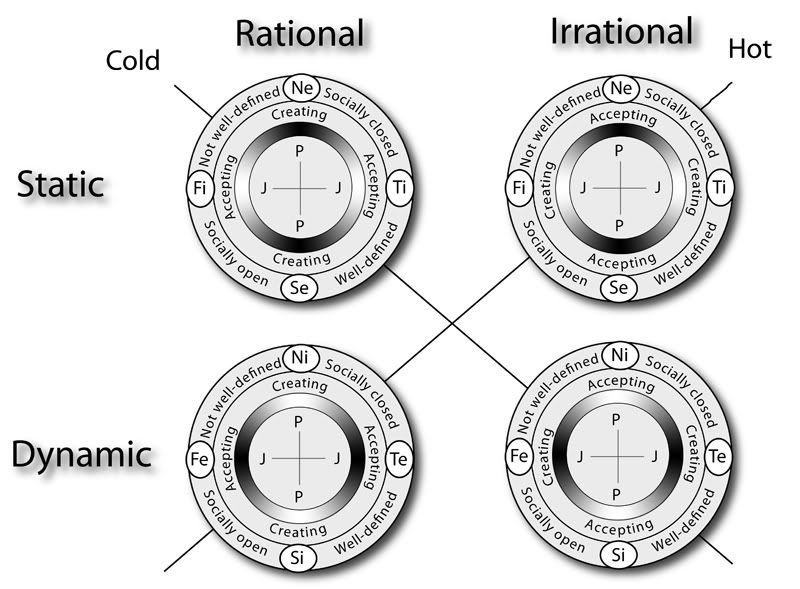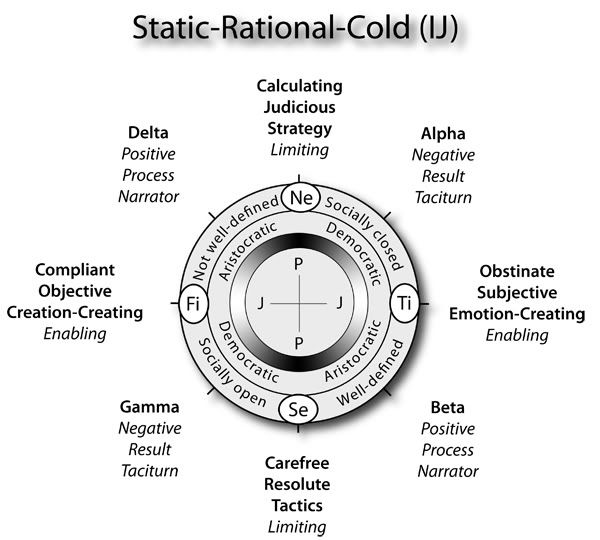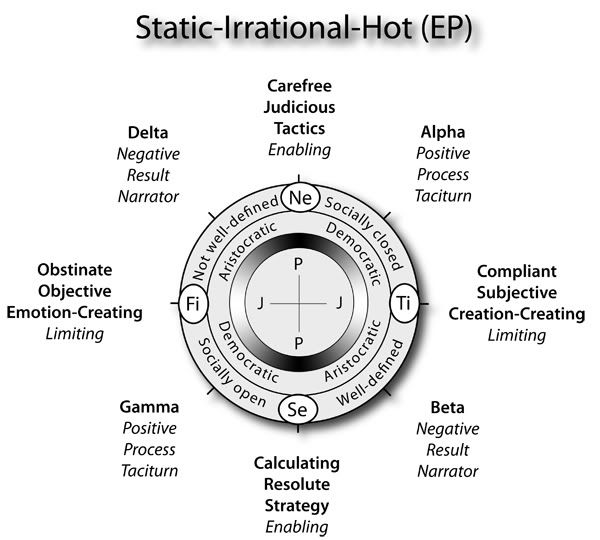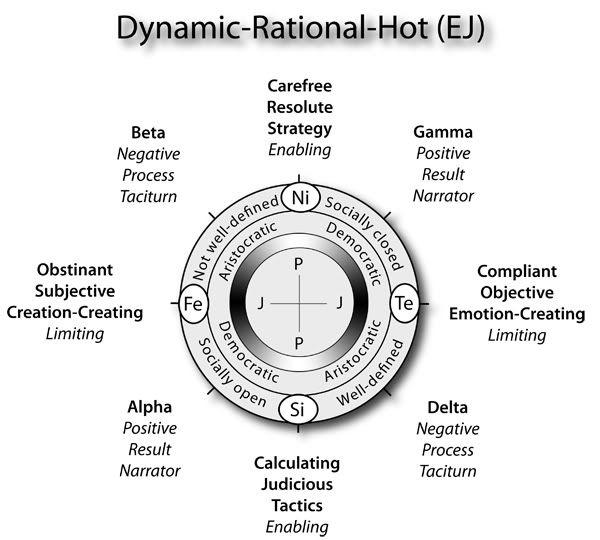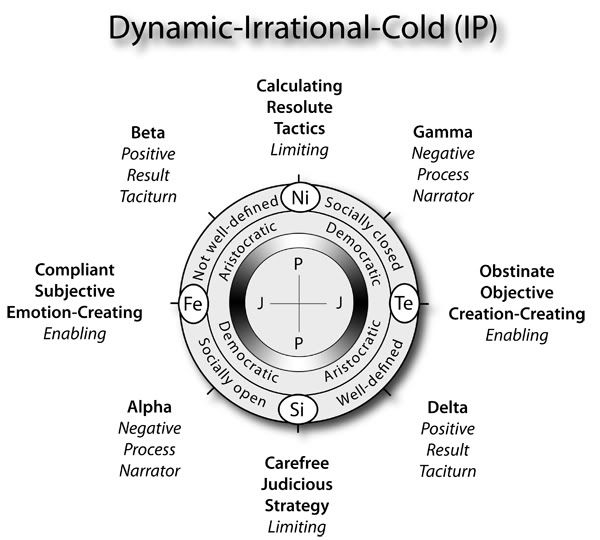In case you happen to have a photographic memory, I feel compelled to warn you this may look a little different from the original.
- Minde
Smilexian Socionics 101.2
The Characters
----------------------------
- Teacher (The Smile)
- Student (The Eyes)
[edited because evidently it isn't broken down into lessons]
:
This is the type of stuff that gives me headaches. I have the feeling, though, that what you're writing should be titled "Advanced" whereas I should be looking at concepts more along the lines of "Beginning" or "Intermediate." The problem is, while I don't understand it, I want to because I think it might help me in my overall understanding of socionics. And I'm not sure what questions to ask you other than, "What does it all mean?" Or, maybe I could ask, "What do I need to know to understand it?"
:
Ah, I fully understand anyone who claims a headache because of that thread. I was not as good at this stuff then as I am now. I've left the material as it was for historical purposes. Yet the concepts in that thread are actually about the very basics of the theory, the things that are behind the types.
The most basic thing to start with would, in my opinion, be the difference between judging and perceiving functions.
The second would be to understand the difference between externalized (well-defined) functions and information and internalized (not-well defined) functions and information. These two issues are the most important in socionics. I would like to clarify these and other issues to you, if you're ok with this. Though, it might not be fast going, since the issues are by their nature difficult.
:
Yes, please. That's why I wrote you. I love clarification, and I don't mind slow goings. Where shall we start?
:
Okay. Before we start I need to point out once more that my views on socionics aren't identical to those of mainstream socionists. It's not far from it, mostly it's a case of slightly different terminology, but there are few differences. And I can only talk about what my own view is. I only know what's giving me good results...
:
Understood. When you depart from the mainstream, could you let me know? And perhaps not only when, but what is different, and why?
:
I'll do as much as I can. The main difference of point of view is that socionists have tried to create a connection to some of Freud's work and have a mainly theoretical psychological background. What psychological experience I have is of practical psychology and my view point of socionics is focused on the life strategy aspect of socionics. I can not accurately describe all aspects of Freudian/ Jungian theory that motivate mainstream socionics, but when I can describe the differences I will.
:
Thank you. That's just what I want.
:
Now, I work much better when I'm given questions that I can answer instead of trying to explain everything that I know or think I know. But I suggested a matter to start with, so I'm going to say something about it, then it's your turn. And that's how we go until we both are confident about you understanding my point on the subject. Then we move to the next bit. Ok?
The most basic and fundamental block would be judging vs. perceiving. The two concepts are linked together. It's not a dichotomy in the sense of one being the opposite of the other. It's about two processes that act in tandem and the real question at any given point is, which of these two processes is pulling the strings.
For practical purposes I will be using old material when I can...
Previously, I said the following about perceiving and judging functions:
Perceiving function:
It relates to a natural state of things, observation of events such as they are. It doesn't involve agreements, ethics or sociality, it doesn't involve purpose. It's just things as they are. It requires judging functions to supply it with purpose and humanity and it supports judging functions by turning their hopes, beliefs and decisions into reality. By its actions changes the focus of a situation from the 'aristocratic' to the 'democratic' ie. enables one to concentrate on the situation that is instead of a principle, communal agreement or prevailing idea.
Judging function:
It relates to an artificial state of things, observation of the way things could be and how they should be. It consists of agreed upon and decided information, ethics, norms, sociality, purpose, infrastructure, social bonds, honor, beliefs, plans, abstractions and hierarchies. It's what we make of the world, it's our humanity. It requires perceiving functions to anchor it into what's actually happening around it and to enable it to create something with its intentions. By its actions it turns 'democratic' into 'aristocratic' ie. it institutionalizes information and structures human activity, creates social roles and groups out of individuals that used to interact with an environment out of their own interests.
Now I would expect that you should generally see our discussion here relating to a judging function and also that this would be the form of the function that you are most using. This is what I call the dominant function. A dominant judging function serves as a bridge between two states of perceiving functions and a dominant perceiving function serves as a bridge between two states of judging functions. The whole of socionics is about a strategy. A strategy has a starting point, the strategy itself which is the tool, and a goal. Your social strategy is a way to solve a certain kind of problem that is existing in your environment. In this sense your Fi, your dominant judging function is a tool that you use to bypass problems of the perceiving kind.
As an example, you would recognize that you have some practical skills with which you can directly affect your environment (in a way defined as a perceptive function use) but you spend most of your energy not with those skills but your judging function concept of how to use those skills in the best way for your environment, which you use in a social way you call puttering. You recognize that this puttering does in fact create another kind of situation but you are not yet at the end of that path, hence you continue to putter. But you do know that at the end of that path there is another situation and another lesson of the perceptive kind. Yes?
:
So, let's see if I can rephrase this. There's the real world around me. There's a certain set of skills I have to interact with that world. But instead of just using those skills, I'm occupying more of my time and effort figuring out why to use those skills. And then I'll end up with something that a perceiving function has to work with. ??
:
Just about so. But I underline that this is an example of a way that your judging and perceiving functions can work together, not the only way to define the same issue. You could also use the same judging function to a) force the use of your practical skills over an issue that you theoretically have insufficient control over b) talk people into giving you opportunities to use those skills c) create a theoretical definition of your skills d) systemize your skills e) create a religious explanation of your skills or a number of other things. The issue is about what meaning you give and how do you present your real capability. In your case accepting Fi would generally relate to keeping a hold of some things (often people) that have proven to be important to you. I would expect a sort of maintenance of the surrounding situation, in whatever way you can.
:
Or, let me try this way:
What I can do to interact with the world - Perceiving
Spending time and effort on the "why" and "how best" - Judging
The end result that I now have to deal with - Perceiving
When I put it like that, I can see how the judging would be a "bridge."
:
Mostly agreed. Though seeing 'the best path' is perceiving. Deciding that what you saw really is 'the best path' is judging. But again, those are only one form that the sequence can take. I'll offer you another example.
For me in my current state it's closer to:
Perceiving: What I know to be good and beneficial in the environment. (Ni)
Judging: What is my role in the environment. (Te)
Perceiving: How I can fulfill the role I have. (Si)
Another ESTj could have another formulation of this same issue.
:
Why are you putting the actual functions in there? How do they relate? Or should I not focus on that?
:
I hoped they would help somehow. I usually believe that giving out information helps. Sometimes like apparently here it just confuses, sorry.
:
And I generally like having extra information. Sometimes I just need clarification of what's extra and what's essential. So don't be sorry.
But what would dominant perceiving look like? How would that "bridge"?
:
Ok, while I was using mainly Ni, my idea of what I was doing was:
Judging: What do people want and like? (Fe)
Perception: Of the things that people don't compete and fight for, what matters actually have uses that people ignore? (Ni)
Judging: Is there an opportunity available for me to do something important? (Te)
Again, there are alternate formulations for the same matter. Not every ENTj would recognize Fe as 'What do people want and like?'. Someone might say it's 'What's virtuous?' or 'Who are my friends?' or something else.
You could say that the perceiving function is the bridge that turns a decision (judging function) into action (perceiving function) in the hope of a meaningful end result (another judging function). Or again, you might formulate that in another way e.g. hypothesis (judging function) -> observation and reflection (perceiving function) -> truthful knowledge (another judging function).
(Differences: Jung seems to have understood the connection between judging and perceiving functions. Socionists and MBTI people often treat judging vs. perceiving rather as two entirely separate issues that are totally incompatible. Most socionists also treat functions as pieces of information, not as processes. They seem to be unable to actually define any of that information though and hence unable to relate it to actual behaviour or its purpose.)
:
I thought I was getting it, but then it slipped away again after reading that. Sorry, no specific questions, just general confusion.
:
I'm not surprised at all. This is the really difficult point about socionics. Thing is, socionics terminology can not be defined with any simple phrases of standard English. The reason is that the terminology is absolutely defined by the socionic system and the system itself has not been part of the English vocabulary. For example the word judging... the idea that is close to socionics judging is the idea of issuing, accepting and understanding verdicts, statements. On the other hand judging has a connotation of using judgment, and actually perceiving functions may be argued to have a closer link to this use of the word on the basis that judgment can be understood to be capability of approximation.
Let me try to put this in another way... There is an idea of the socioc term 'judging,' and there are many definitions of this idea that are serviceable but not identical to the actual idea. One can say that judging is 'making and committing to plans' and that's not entirely incorrect, but 'making and committing to plans' is not the same thing as judging. To say that judging is 'creating social bonds' is also close to correct, as is saying that judging is 'creating a theory'. All of those definitions and others of their kind form a cluster of ideas around the actual concept of judging. What is important is to be able to recognize issues that have this property of judging, issues that have the property of perception, and issues that more or less share characteristics of both...
e.g.
Driving a car ... the manual task of operating the wheel, gear shift and pedals is perceptive, as is the approximation of distances to other vehicles, knowing your orientation and place on a city grid, in what direction you should be moving, and how long will it take to get there.
On the other hand, knowing the traffic rules and deciding whether to stop at a yellow light, whether to give way to pedestrians or whether to drive recklessly caring only about getting to the end point quickly, these are judging issues.
Thus one can not say that driving a car is totally 'judging' or 'perceptive'.
:
So... Perceiving is more like "what is" and judging is more like "what one thinks/feels/decides about what is"?
:
Very much so. Yes, you are making progress.
More examples:
Sowing a button - entirely a perceiving task.
Acting as a translator between english and french - entirely a judging task.
Writing a poem - almost impossible to define on the level of judging vs. perceiving.
The clearest manifestations of perceiving can be seen in the function Se. A person using Se notices that something is doable and then does it. This is perceiving at its simplest.
Likewise judging is most easy to observe in Te. A Te person can say: "We must try to lose some weight." The commitment to a task, the message, the position is exceedingly clear, but there is in the statement little hint of what method is to be used. It's in many ways a social message. A clarification of the relation between the I and the concept in question.
:
Let me try an example. Cooking... knowing what ingredients are available, knowing their properties and how they interact with each other, the acts of putting them together, adjusting temperature, approximating how much will be needed and consumed, these are perceiving. Deciding what to cook, what ingredients to use and how much of each, how much effort should go into the dish, and whether to serve it nicely or just plop it on the table, these are judging.
How was that? Close?
:
Very good! In most cases it would be just so. Let's look at an advanced example around the subject of cooking... Let's say that a person is supposed to decide when to take the cake from the oven. The judging person could look at what it says in the recipe, or ask for advice, or have a premade rule of thumb about the subject. The perceptive person would look at the cake and decide whether it looks ready, or take it from the oven when he has time, or when it smells good or something similar.
:
So, if you take it out when the recipe says so, that's judging? And if you take it out 'cause it looks done, that's perceiving? What if you take it out because someone's taught you what it looks like when it's done? Has that gained a judging element (since there's now a previously defined expectation/standard)?
:
I'd say that's a bit of a borderline case, and there are many many such. It would depend on the point of view of the person doing the decision I suppose. One might say that it would seem to be mostly perceiving but including - as you put it - a judging element. The gray area between the judging and the perceiving is rather large.
And more....
Let's say someone says:
"Girls are better students than boys." This can be a matter of perception. The person in question may have seen that girls around him get better grades than boys and is just telling what he sees. OR it can be an issue of judging. The person may have looked at some statistics and noticed the same trend, then the person proceeds to make a statement of it and decides that girls are better students than boys. For the perceptive any single girl is not by definition a better student than a boy, but for the judging person a girl would henceforth be by definition a better student than a boy.
The perceptive function relates to a thing itself and the judging function relates to matters that 'are decidedly known about the thing'. Judging information has to go through a kind of level of abstraction.
:
And this is confusing...
Oh, well. Two steps forward, one step back. At least we're making progress.
:
Yes, we are. Let me rephrase this issue... The perceptive person would really be saying in his own opinion "I have noticed that girls seem to be better students than boys." whereas the judging person is really trying to say "It's a well known issue that girls just are better students than boys." There is a level of abstraction from the immediate observation in the judging function. In this sense truth is a claim that is supposed to correspond to how things are. The value of knowing something is true is that one does not have to check the fact every time by observation. Sometimes this truth is contrary to immediate observation. E.g. a patient does not seem ill, yet a doctor may know due to some lab results that he in fact is very ill. Hence, it can be true that he is ill, though he does not seem like it or feel like it. OTOH a stubborn person can claim e.g. for social reasons that something is true even if s/he has ironclad evidence right in front of him/her that the matter is not as s/he claims. Sometimes truths work better than observation, sometimes not so. Judging could be understood as personally accepted facts.
:
How is "observation" different from "truthful knowledge"? Oh, and it's making more sense again. I think.
:
The concept of truth is meaningless from the perceptive point of view. Perception says 'things just are as they are'. Judging function makes the approximation of what is true and what is not. Look at the above example of girl/boy students. It's the same issue.
:
Wait, I thought perceiving was about making approximations. And isn't "truth" the same as "what is"?
:
Quite so. Thing is, you never know by making an observation the actual true nature of a thing as your capacity to measure and understand what you see and hear is limited. So every observation is an approximation as well. What you observe becomes true only when you decide that you have observed something significant correctly. (Or that some other source is capable of giving you 'true' information.)
:
Okay, I think I got it. There's the actual truth (perceiving) and then what you decide is truth (judging). Yes?
:
Well, yes, essentially so. Though one shouldn't disregard the number of cases in which the perceiving information is easily misleading ... think on the lines of 'the earth is clearly flat, not round'.
:
Earlier you said that this discussion itself was judging. How is that? Or is that not what you're saying?
:
Two answers. First of all, you are using a judging function and I'm using a judging function, hence communication is by default on a level of judging function (mainly).
:
What judging function is that?
:
Accepting Te on my part and accepting Fi on your part.
Secondly, the matters I'm saying, I'm mainly 'teaching by rote' here. There is no aspect of benefit involved. I talk about a matter you want to know about. The focus is on the social opportunity. You can also note that we are both using our accepting (therefore judging functions) by the fact that neither one of us is trying to use control or tricks over the others, there is no pressure.
:
Now you've thrown "accepting" into the mix. How does accepting equal judging?
:
It doesn't equal judging. For all xxxj -types as in INFj, ESTj, ENFj etc. their judging functions are also accepting functions. For xxxp types as in ESFp, ISTp, ENTp etc. their judging functions are creative functions and their perceptive functions are accepting functions. Hence what I meant was that since we both are xxxj-types, for us, judging functions are also accepting functions. But let's return to that also, later.
:
Is perceiving v. judging similar to objective v. subjective?
:
No. In socionics parlance, both 'objective' and 'subjective' are characteristics of judging functions. Perceptive functions can't belong to either cathegory. Matters corresponding to a judging function can be important either because they are something you uphold yourself, or they can be important because they are accepted generally. This differentiates whether they are objective or subjective. But let's return to that dichotomy later. We're still essentially in judging vs. perceiving. (Perceiving functions can also be personal or general in a sense. Si and Ne are personal whereas Ni and Se are more general. But again, we should return to this later. )
Some choices that are perceiving:
a) Do strawberries taste better than cloudberries?
b) Is a bicycle faster than a pair of rollerskates?
Some choices that are judging:
c) Will I forgive a crime?
d) Do I wear a safety belt in the car?
In a sense, a and c could be called subjective whereas b and d could be called objective. There is 'correct information' regarding b and d whereas a and c depend mainly on the person making the choice. You may also notice that perceiving decisions are more about making an approximation whereas judging are more about making a decision.
:
So there actually is a reason why they're called "judging" and "perceiving"? I think I'm getting this part, at least.
:
I also think that you're starting to have this issue pretty well in hand. If you're feeling confident yourself we can move on to the issue of introversion vs. extroversion...
:
Sounds good to me.
:
Okay, wonderful!



 Reply With Quote
Reply With Quote ,
,  and other functions don't copy-paste that well. Some of them might be missing from some sentences. I appreciate if anyone bothers to notify me about sentences that don't seem to make any sense, there's possibly a function-name missing.
and other functions don't copy-paste that well. Some of them might be missing from some sentences. I appreciate if anyone bothers to notify me about sentences that don't seem to make any sense, there's possibly a function-name missing.


